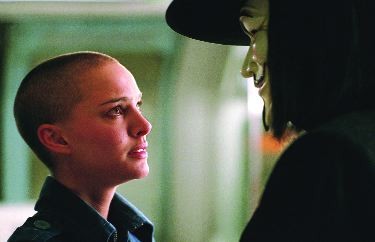Jesus the priest

Extremism in the defense of liberty is no vice, and moderation in the pursuit of justice is no virtue.
—Barry Goldwater (with thanks to Thomas Paine)
Blowing up a building can change the world.
—V
The notion that terrorist acts may be necessary to topple an evil regime usually finds cinematic treatment in low-budget films dealing with the Irish Revolutionary Army or the Black Power movement. But V for Vendetta is a big-budget mainstream release with a huge advertising budget.
The slick-looking film, based on a comic-book novel by Alan Moore and David Lloyd, takes place in London in the year 2020. Global wars have led to political crackdowns and the rise of totalitarian regimes, including a fascist government in England led by Chancellor Sutler (John Hurt), whose twisted face and snarling commands are kept before the populace by means of large video screens, à la George Orwell’s 1984. Under Sutler’s iron fist, civil rights have been eliminated, along with pleasures such as music, art and, for some reason, butter.
But one man is fighting back, a man in black named V (Hugo Weaving), who wears a long wig and a Guy Fawkes mask in honor of the political terrorist who tried to blow up Parliament and assassinate King James I in 1605. (Fawkes was part of a group of Roman Catholic conspirators. His plot failed, and he was drawn and quartered.)
V is part superhero, part revolutionary—or part Zorro, part Robin Hood. His murky past and motivations are gradually revealed as the film plays out, but what is most important is that his weapon of choice is the bomb, which he uses to destroy symbols of the regime he despises. (The film begins with him orchestrating the blowing up of the Old Bailey courthouse while the “1812 Overture” blares over the public loudspeakers.)
V’s cohort (necessary for the plot, since it’s through her questions that we learn about the mysterious V) is a gamine named Evey Hammond (Natalie Portman), who works as a gofer at the television network. Her radical parents were kidnapped by the secret police. She is immediately drawn to V’s courage and commitment, and despite some initial misgivings about the brutality of his plans, she is won over to his project, especially when she visits him in his sprawling underground lair, which features paraphernalia banned by the Ministry of Objectionable Material. V’s treasures include a juke box that plays “Cry Me a River” and a movie poster for White Heat (a film that ends, not coincidentally, with a huge explosion). V also adores the 1934 movie version of The Count of Monte Cristo, which he watches again and again, clearly identifying with its swashbuckling hero Edmund Dantes.
The film is thick with secondary characters, including a blowhard right-wing talk-show personality, a gay host of a left-wing variety show, a hangdog chief detective and a truly malignant head of the secret police (with the wonderful name of Creedy).
The screenplay is by the Wachowski brothers, Larry and Andy, who wrote and directed the Matrix trilogy. (They have handed off the directing chores here to first-timer James McTeigue, a veteran of television commercials.) This film resembles Matrix in its visually sumptuous, emotionally exaggerated way of dealing with good and evil, though it is more realistic. As with Matrix, the target audience seems to be teenagers—which explains why the political themes are sugar-coated with plenty of slow-motion martial arts scenes.
V is slightly mad, and the bad guys verge on the cartoonish. Though this makes it hard to take seriously some of the larger questions being posed—such as whether ends can justify means and whether one person can ever take it upon himself or herself to be judge and jury—the movie at least puts these questions into play. Vendetta may be political propaganda designed for the multiplexes, but it can be a good place to start a discussion.





